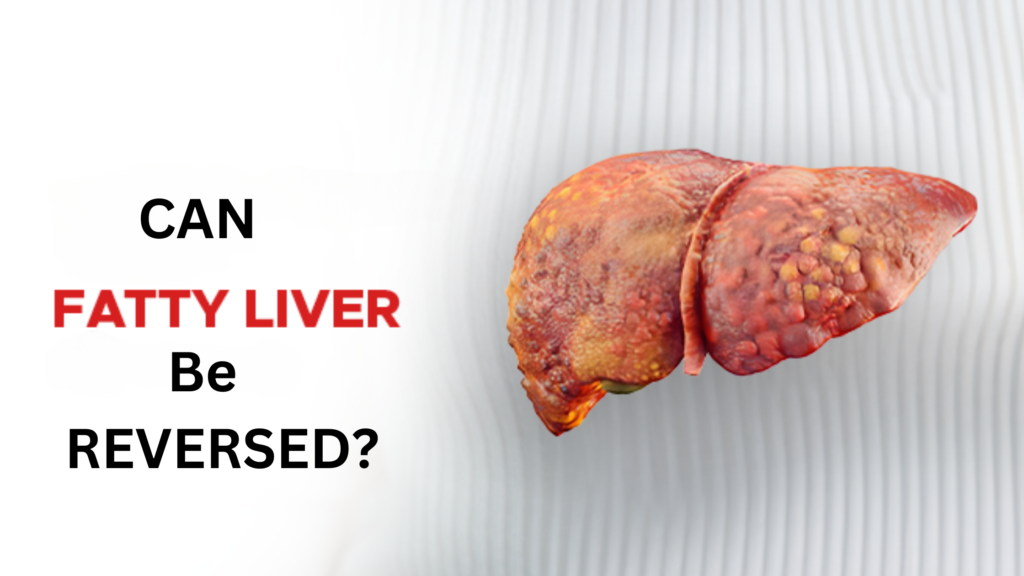
Table of Contents
ToggleWhat is Fatty Liver Disease?
Fatty Liver is a diseased condition in which excess fat builds up in the liver. Having small amounts of fat in your liver is normal, but too much can damage the organ and leads to serious complications. Fatty liver is also known as Hepatic Steatosis.
Liver is the largest organ inside your body. It helps your body digest food, store energy, and remove poisons.
Types of Fatty Liver Disease
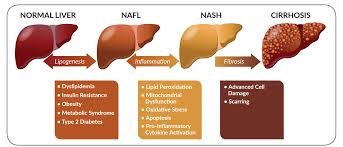
There are two main types:
• Nonalcoholic fatty liver disease (NAFLD)
• Alcoholic fatty liver disease, also called Alcoholic Steatohepatitis
NAFLD is a type of fatty liver disease that is not related to heavy alcohol use. There are two kinds:
• Simple fatty liver, in which you have fat in your liver but little or no inflammation or liver cell damage. Simple fatty liver typically does not get bad enough to cause liver damage or complications.
• Nonalcoholic steatohepatitis (NASH)/ Metabolic Dysfunction Associated Steatotic Liver Disease (MASLD), in which you have inflammation and liver cell damage, as well as fat in your liver. Inflammation and liver cell damage can cause fibrosis, or scarring, of the liver. NASH may lead to Cirrhosis or Liver Cancer
Acute Fatty Liver of Pregnancy (AFLP)
Acute fatty liver of pregnancy (AFLP) is when excess fat builds up in the liver during pregnancy. It’s a rare but serious pregnancy complication. The exact cause is unknown, although genetics may be a reason.
When AFLP develops, it usually appears in the third trimester of pregnancy. If left untreated, it poses serious health risks to the mother and baby.
If a doctor diagnoses AFLP, they will want to deliver your baby as soon as possible. You might need to receive follow-up care for several days after you give birth.
Your liver health will likely return to normal within a few weeks of giving birth.
Alcoholic Fatty Liver Disease or Alcoholic Steatohepatitis is due to heavy alcohol use. Your liver breaks down most of the alcohol you drink, so it can be removed from your body. But the process of breaking it down can generate harmful substances. These substances can damage liver cells, promote inflammation, and weaken your body’s natural defenses. The more alcohol that you drink, the more you damage your liver. Alcoholic fatty liver disease is the earliest stage of alcohol-related liver disease. The next stages are alcoholic hepatitis and cirrhosis.
Causes of Fatty Liver Disease
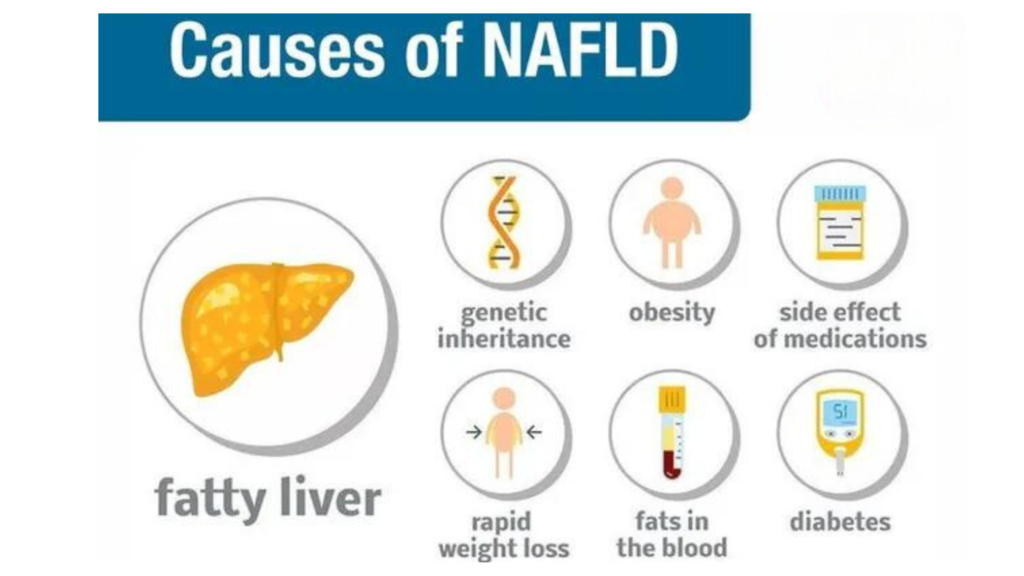
Experts don’t know exactly why fat builds up in some livers and not others. They also don’t fully understand why some fatty livers turn into NASH.
NAFLD and NASH are both linked to the following:
• Genetics.
• Overweight or obesity.
• Insulin resistance, which happens when your cells don’t take up sugar in response to the hormone insulin.
• Type 2 diabetes, sometimes called high blood sugar or hyperglycaemia.
• High levels of fats, especially triglycerides, in the blood.
These combined health problems may contribute to a fatty liver. However, some people get NAFLD even if they do not have any risk factors.
Risk Factors of Fatty Liver
Many diseases and health problems can increase your risk of NAFLD, including:
• Family history of fatty liver disease or obesity.
• Growth hormone deficiency, which means the body doesn’t make enough hormones to grow.
• High cholesterol.
• High levels of triglycerides in the blood.
• Insulin resistance.
• Metabolic syndrome.
• Obesity, especially when fat is centered in the waist.
• Polycystic ovary syndrome.
• Obstructive sleep apnea.
• Type 2 diabetes.
• Underactive thyroid, also called hypothyroidism.
• Underactive pituitary gland, or hypopituitarism.
• Have hypogonadism (low sex hormones)
• Take certain drugs, such as corticosteroids and some cancer drugs
• Have certain metabolic disorders, including metabolic syndrome.
• Have rapid weight loss
• Have certain infections, such as Hepatitis C
• Have been exposed to some toxins
Who are more likely get affected by Fatty Liver Disease?
• People older than 50.
• People with certain genetic risk factors.
• People with obesity.
• People with diabetes or high blood sugar.
• People with symptoms of metabolic syndrome, such as high blood pressure, high triglycerides and a large waist size
Symptoms of Fatty Liver Disease
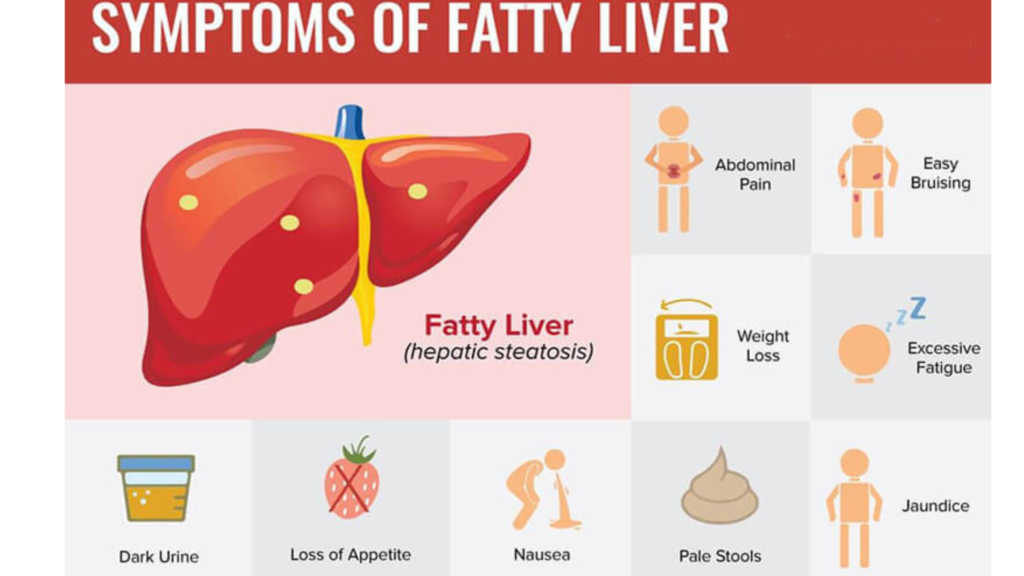
Fatty Liver Disease doesn’t always cause symptoms. When they are present, symptoms include
• Abdominal pain or a feeling of fullness in the upper right side of abdomen (belly)
• Extreme exhaustion or weakness (fatigue)
More commonly, people notice symptoms once Fatty Liver Disease has progressed to cirrhosis of the liver. When cirrhosis develops, you may experience:
• Nausea
• Loss of appetite
• Unexplained weight loss
• Yellowish skin and whites of the eyes (Jaundice)
• Swelling in your abdomen (Ascites)
• Swelling in your legs, feet or hands (oedema)
• Bleeding finds in oesophagus, stomach or rectum.
Fatty liver can progress through four stages including:
1. Simple fatty liver: There’s a build-up of excess fat in the liver. Simple fatty liver is largely harmless if it doesn’t progress.
2. Steatohepatitis: In addition to excess fat, there’s inflammation in the liver.
3. Fibrosis: Persistent inflammation in the liver has now caused scarring. However, the liver can still generally function normally.
4. Cirrhosis: Scarring of the liver has become widespread, impairing the liver’s ability to function. This is the most severe stage and is irreversible.
The liver damage due to cirrhosis is permanent. That’s why it’s so important to prevent it from developing in the first place.
Diagnosis of Fatty Liver Disease
To diagnose fatty liver, a doctor will take your medical history, conduct a physical exam, and order one or more tests.
If a doctor suspects that you might have fatty liver, they will likely ask you questions about:
• your family medical history, including any history of liver disease
• your alcohol consumption and other lifestyle habits
• any medical conditions you might have
• any medications you might take
Physical exam
To check for liver inflammation, a doctor may palpate or press on your abdomen. If your liver recent changes in your health
Let a doctor know if you’ve been experiencing fatigue, loss of appetite, or enlarged other unexplained symptoms.
However, it’s possible for your liver to be inflamed without being enlarged. A doctor might not be able to tell if your liver is inflamed by touch.
Blood tests
In many cases, fatty liver disease is diagnosed after blood tests show elevated liver enzymes. For example, a doctor may order the alanine aminotransferase test (ALT) and aspartate aminotransferase test (AST) to check your liver enzymes.
A doctor might recommend these tests if you’ve developed signs or symptoms of liver disease, or they might be ordered as part of routine blood work.
Elevated liver enzymes are a sign of liver inflammation. Fatty liver disease is one potential cause of liver inflammation, but it’s not the only one.
If your test results are positive for elevated liver enzymes, a doctor will likely order additional tests to identify the cause of the inflammation.
Imaging studies
A doctor may use one or more of the following imaging tests to check for excess fat or other problems with your liver:
• ultrasound exam
• CT scan
• MRI scan
They might also order a test known as vibration-controlled transient elastography (VCTE, FibroScan). This test uses low frequency sound waves to measure liver stiffness. It can help check for scarring.
Liver biopsy
A liver biopsy is considered the best way to determine the severity of liver disease.
During a liver biopsy, a doctor will insert a needle into your liver and remove a piece of tissue for examination. They will give you a local anaesthetic to lessen the pain.
This test can help determine whether you have fatty liver disease and liver scarring.
How to keep your Liver Healthy if you have been diagnosed with Fatty Liver Disease?
If you have been diagnosed with Fatty Liver Disease, it is important to keep your liver as healthy as possible and avoid anything that can damage your Liver. Here are some important things you should do.
• Don’t drink too much alcohol. How much is too much remains controversial, but it’s probably best to avoid alcohol completely.
• Make sure that none of your medications, herbs and supplements are toxic to the liver.
• Get vaccinated to protect against liver viruses Hepatitis A and B
• Control other health condition that might also affect your liver, and check with your doctor if you might have other underlying, treatable diseases contributing to your Fatty Liver.
• Get regular screening tests for liver cancer if you already have Cirrhosis.
Lose Weight
Weight loss of roughly 5% of your body weight might be enough to improve abnormal liver tests and decrease the fat in the liver. Losing between 7% and 10% of body weight seems to decrease the amount of inflammation and injury to liver cells, and it may even reverse some of the damage of fibrosis. Target a gradual weight loss of 1 to 2 pounds per week, as very rapid weight loss may worsen inflammation and fibrosis. You may want to explore the option of weight loss surgery with your doctor, if you aren’t making any headway with weight loss and your health is suffering.
Eat well
Some studies suggest that the Mediterranean diet may also decrease the fat in the liver. This nutrition plan emphasizes fruits, vegetables, whole grains, legumes, nuts, replacing butter with olive or canola oil, limiting red meat, and eating more fish and lean poultry.
Drink Coffee
Some studies showed that patients with NAFLD who drank coffee (about two cups every day) had a decreased risk in fibrosis. However, take into consideration the downsides of regular caffeine intake.
Even though it can be difficult to make these lifestyle changes and lose the weight, the benefit is immense if you have fatty liver, so give it your best effort! And remember, the greatest risk for people with a fatty liver is still cardiovascular disease. Not only can some of these lifestyle changes improve or resolve your fatty liver, they will also help keep your heart healthy.
Diet for Fatty Liver Disease
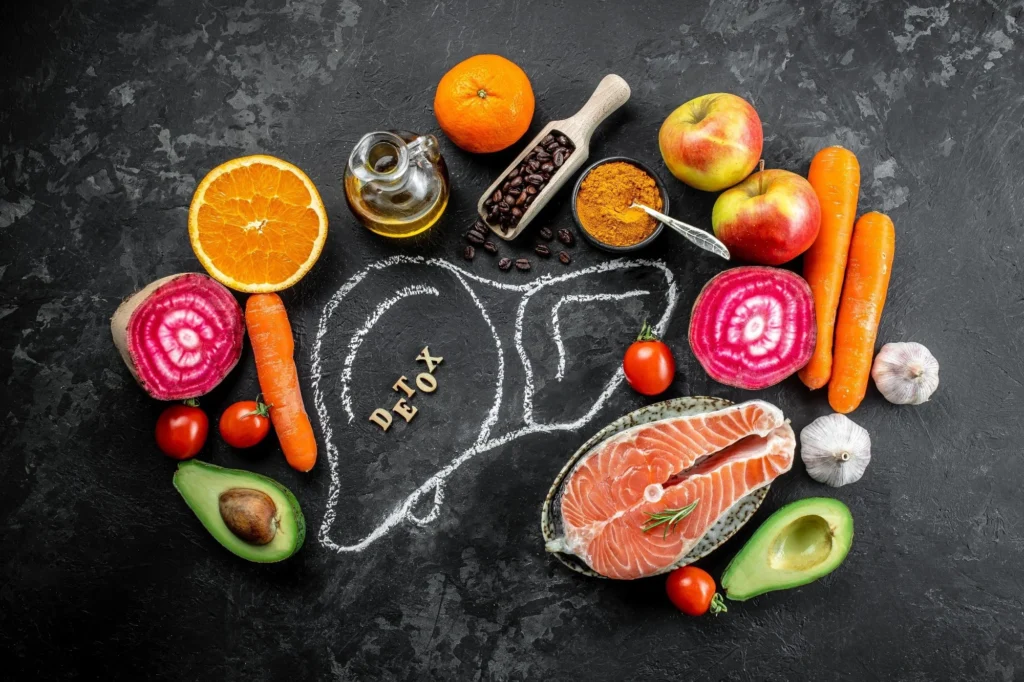
If you have fatty liver disease, a doctor might encourage you to adjust your diet to help treat the condition and lower your risk of complications.
For example, they might advise you to do the following:
• Balance your diet: Try to select foods from all food groups. This includes fresh fruits and vegetables, whole grains, lean proteins, low fat dairy, and healthy fats and oils.
• Cut calories: Aim to limit your consumption of foods that are high in calories.
• Focus on fiber: Fiber can help improve the function of your liver. Example of foods that are rich in fiber include fresh fruits and vegetables, legumes, and whole grains.
• Limit certain foods: Take steps to reduce your consumption of foods that are high in:
o sodium (salt)
o refined carbohydrates, such as sweets, white rice, white bread, or other refined grain products
o saturated fats, which are found in foods such red meat, full fat dairy, and fried foods
o trans fats, which are present in fried foods
• Avoid raw or undercooked shellfish: Raw or undercooked shellfish can contain bacteria that can make you seriously ill.
• Address alcohol: Talk with a doctor about whether you can have alcohol. Depending on the condition of your liver, you may be able to drink alcohol in moderation. If you have AFLD, you’ll need to abstain from alcohol entirely.
• Drink water: Drinking plenty of water can help keep you hydrated and also improve the health of your liver.
Learn more about some of the other dietary changes that may help you manage fatty liver disease.
Prevention
To prevent fatty liver disease and its potential complications, it’s important to follow a healthy lifestyle. Some general prevention tips include:
• limiting or avoiding alcohol
• managing your weight
• eating a nutrient-rich diet that’s low in saturated fat, trans fat, and refined carbohydrates
• taking steps to manage your blood sugar, triglyceride levels, and cholesterol levels
• following your recommended treatment plan for diabetes, if you have this condition
• aiming for at least 30 minutes of exercise most days of the week
Taking these steps can also help improve your overall health.
Conclusion
Fatty liver disease is when excess fat accumulates in the liver. This can happen due to heavy alcohol use. In this case, it’s known as alcoholic fatty liver disease (AFLD).
When fatty liver occurs in someone who doesn’t drink much alcohol, it’s known as non-alcoholic fatty liver disease (NAFLD).
Many people with fatty liver disease don’t experience significant symptoms until severe liver damage has occurred. When early symptoms are present, they can be nonspecific and include things like upper right abdominal pain and fatigue.
The primary treatment for fatty liver disease is to make lifestyle changes that promote liver health. It’s possible for the damage caused by fatty liver disease to be reversed when it’s treated in its early stages.
